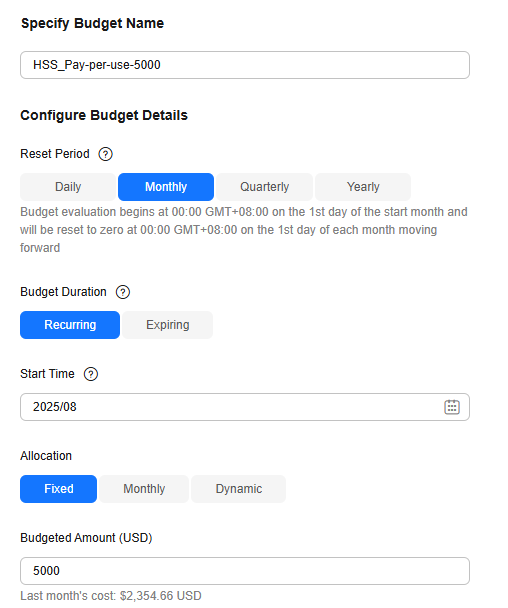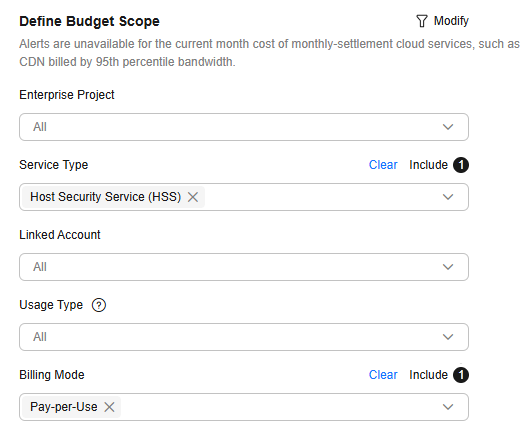Cost Management
As you migrate more of your services to the cloud, managing cloud costs becomes more important. For example, you may be more concerned with cost management when using HSS. The following describes how to manage costs in terms of cost composition, allocation, analysis, and optimization. Optimizing costs can help you maximize return on investment.
Cost Composition
HSS costs consist of two parts:
- Resource costs: cost of resources and resource packages, depending on the billing items of HSS. For details, see Billing Items.
- O&M costs: labor costs incurred during the use of HSS.
Huawei Cloud Cost Center helps you manage resource costs efficiently. You need to identify, manage, and optimize O&M costs on the page.
Cost Allocation
A good cost accountability system is a prerequisite for cost management. It ensures that departments, business teams, and owners are accountable for their respective cloud costs. An enterprise can allocate cloud costs to different teams or projects so as to have a clear picture of their respective costs.
We provide multiple tools for you to optimize cost allocation in Cost Center.
- By linked account
The enterprise master account can manage costs by grouping the costs of its member accounts by linked account. For details, see Viewing Costs by Linked Account.
- By enterprise project
Before allocating costs, enable Enterprise Project Management Service (EPS) and plan your enterprise projects based on your organizational structure or service needs. When purchasing cloud resources, select an enterprise project so that the costs of the resources will be allocated to the selected enterprise project. For details, see Viewing Costs by Enterprise Project.
Figure 1 Selecting an enterprise project for HSS
- By cost tag
You use tags to sort your Huawei Cloud resources in a variety of different ways, for example, by purpose, owner, or environment. The following is the process of managing costs by predefined tags (recommended).
 Figure 2 Adding tags for HSS
Figure 2 Adding tags for HSS
For details, see Viewing Costs by Cost Tag.
- By cost category
You can use Cost Categories in Cost Center to split shared costs. Shared costs are the costs of resources (compute, network, storage, or resource packages) shared across multiple departments or the costs that cannot be directly split by cost tag or enterprise project. These costs are not directly attributable to a singular owner, and they cannot be categorized into a singular cost type. In this case, you can define cost splitting rules to fairly allocate these costs among teams or business units. For details, see Viewing Cost By Cost Category.
Cost Analysis
To precisely control and optimize your costs, you need a clear understanding of what parts of your enterprise incurred different costs. Cost Center visualizes original costs and amortized costs in various dimensions and through filters so that you can analyze service usage costs, trends, and factors from a variety of perspectives and scopes.
You can also use Cost Anomaly Detection in Cost Center to detect unexpected expenses in a timely manner. In this way, costs can be monitored, analyzed, and traced.
For details, see Performing Cost Analysis to Explore Costs and Usage and Enabling Cost Anomaly Detection to Identify Anomalies.
Cost Optimization
- Cost control
You can create different types of budgets on the Budgets page of Cost Center to track your costs against the budgeted amount you specified. If the budget thresholds you defined are reached, Cost Center will send alerts to the recipients you configured. You can also create budget reports and specify recipients to receive budget alerts if any at a frequency you configured.
Suppose you want to create a monthly budget of $5,000 USD for pay-per-use HSS and expect to receive an alert if the forecasted amount exceeds 80% of the budgeted amount. You can refer to the following budget information.
Figure 3 Basic budget information Figure 4 Defining the budget scope
Figure 4 Defining the budget scope Figure 5 Setting a budget alert
Figure 5 Setting a budget alert
For details, see Enabling Forecasting and Creating Budgets to Track Costs and Usage.
- Billing mode selection
Different types of services have different requirements on resource usage periods, so the most economical billing mode for one resource may not be the best option for another resource.
- For mature services that tend to be stable for the long term, select yearly/monthly billing.
- For short-term, unpredictable services that experience traffic bursts and cannot afford to be interrupted, select pay-per-use billing.
Feedback
Was this page helpful?
Provide feedbackThank you very much for your feedback. We will continue working to improve the documentation.See the reply and handling status in My Cloud VOC.
For any further questions, feel free to contact us through the chatbot.
Chatbot





